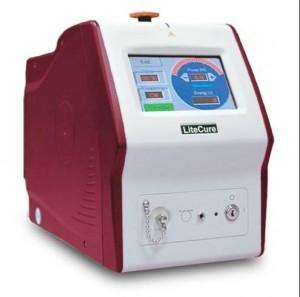
March, 2014:“Recently my 16 year old poodle/maltese cross dog, Rascal, was totally debilitated when she lost the use of her back legs due to disc problems in her spine. I was devastated to see her suffering and thought we would need to have her put down. Fortunately, Dr. Thrush recommended laser therapy to treat the problem area. Rascal’s condition improved with each session and she was walking again in a week. It was unbelievable how well this non-invasive treatment worked and I would highly recommend laser therapy and Brandon Hills Veterinary Clinic for your pet!”
Lorrie Dyer – Rivers, Manitoba
We are proud to offer Laser Therapy as a revolutionary new technology for treating pets. What is Laser Therapy?
Laser Therapy is a relatively new biotechnology that uses the science of photobiostimulation to speed healing. As the Therapy Laser reaches an injured area, this interaction of light and tissue encourages the production of energy and certain chemical mediators inside the damaged cells. The result is that the injured cells begin the cascade of events necessary for healing such as collagen and enzyme production, cell growth, and increased blood flow. As our pets age, recover from trauma or surgery, or simply need relief from everyday aches and pains, this advanced technology offers drug-free, surgery-free, pain-free relief. There are no known side-effects of deep tissue laser therapy, and treatments are non-invasive.
The Companion Therapy Laser used at Brandon Hills Veterinary Clinic was recognized as one of the World’s Best Veterinary Products of 2009 by ABC’s popular morning show, Good Morning America. The Companion Therapy Laser is exciting new technology that has been successful in speeding wound healing and in reducing pain and inflammation caused by common pet ailments such as otitis (ear infections), hip dysplasia, and arthritis, among others. The Companion Therapy Laser is designed specifically for treating pets, but the same technology is also FDA-approved for use on humans. Laser Therapy for humans is commonly used by clinicians treating chronic and acute musculoskeletal pain. At least fifteen professional sports teams are using therapy lasers, and Laser Therapy traveled to the Beijing Olympics treating athletes from basketball players to race horses.
What will the application of laser therapy do for my pet?
Simply put, it provides RELIEF.
- The Companion Therapy Laser System allows your pet to heal faster after surgery or any traumatic injury.
- It eases pain and provides mobility without the use of pharmaceuticals or surgery.
- Laser Therapy provides your geriatric pet relief from aches and pains, and allows for more freedom of movement and improved quality of life.
- Everyday disorders such as lick granulomas and ear infections that cause severe pain and discomfort are instantaneously relieved.
Laser Therapy applied with the Companion Therapy Laser System provides a sterile, pain-free, surgery- free, drug-free treatment which is used to treat a variety of injuries, wounds, fractures, neurological conditions, numerous dermatological (skin) problems, and pain. Whether your pet is rehabilitating from trauma or injury, healing from wounds, or simply aging, your companion will benefit from this revolutionary new approach to veterinary medicine.
Laser Therapy is the only course of treatment that actually stimulates the body to heal from within. Non-thermal photons of light are administered to the body and are absorbed by injured cells. These cells are then stimulated and respond with a higher rate of metabolism. This results in increased circulation to the treated tissues, an anti-inflammatory reaction, relief from pain, and an acceleration of the healing process.
What types of disorder respond to Laser Therapy?
These are some of the disorders that respond to laser therapy:
- arthritis
- hip dysplasia
- numerous skin conditions
- post surgical pain relief and faster healing
- otitis (ear infections/inflammation)
- wound healing
- degenerative joint disease
- gingivitis
- insect bites/stings
- lacerations/abrasions
- cystitis (bladder infections/inflammation)
- burns
- plus more…
How is Laser Therapy applied to my pet?
Laser Therapy involves passing a beam of laser light over your pet’s skin, directly above the area where your pet has some discomfort, inflammation, or injury. Unlike a surgical laser, Therapy Lasers do not cut or burn tissue, they HEAL tissue. Your pet experiences a feeling of warmth penetrating to the exact spot where the tissue needs help. The beam of laser light is passed over the area for several minutes (the length of time varies with the size of the pet and the size of the treatment area). During this time your pet will be extremely comfortable and relaxed. The beam of laser light will be transmitting laser energy into the targeted cells during this time. This has several effects on different tissue types, depending on the laser settings. In the case of healing, the effect of the laser is to cause the cells to reproduce or regenerate at a faster rate leading to a more rapid healing process. The laser also significantly reduces the pain associated with injury and inflammation by stimulating the production of natural endorphins within the target tissue and by desensitizing nerves in the treated area. In addition, the laser causes dilation of the blood and lymphatic vessels within the tissue, increasing blood flow to the area and reducing swelling.
How do Therapy Lasers work? (The science behind it all.)
Clinical studies and trials of Laser Therapy technology give evidence of the following beneficial effects of laser light therapy on tissues and cells:
- Accelerated Tissue Repair And Cell Growth. Photons of light from lasers penetrate deeply into tissue and accelerate cellular reproduction and growth. The laser light increases the energy available to the cell so that the cell can take on nutrients faster and get rid of waste products more readily. As a result of exposure to laser light, the cells of tendons, ligaments, muscles, and other tissues are repaired faster.
- Faster Wound Healing. Laser light stimulates fibroblast development in damaged tissue (fibroblasts are producers of collagen, and are the predominant cells in wound healing). Collagen is the essential protein required to replace old tissue or to repair injured tissue. As a result, Laser Therapy speeds the healing of wounds and burns.
- Reduced Fibrous (Scar) Tissue Formation. Laser Therapy reduces the formation of scar tissue following tissue damage from cuts, scratches, burns or surgery. Scar tissue that is already present will be stimulated to remodel into normal elastic tissue.
- Anti-Inflammatory Effects. Laser Therapy reduces edema (swelling with fluid) as it causes dilation of blood vessels and as it activates the lymphatic drainage system (drains swollen areas). As a result, there is a reduction in swelling caused by bruising or inflammation.
- Pain Relieving (Analgesic) Effects. Laser Therapy has a highly beneficial effect on nerve cells which is to decrease nerve cell sensitivity, thus stopping pain sensation from being transmitted by these cells to the brain. Also, due to the laser’s anti-inflammatory effects, there is less edema and less pain. Another pain blocking mechanism involves the production of high levels of pain killing chemicals such as endorphins and enkephalins from the brain and adrenal gland.
- Improved Vascular Activity. Laser light will significantly increase the formation of new capillaries in damaged tissue, which speeds up the healing process by bringing more blood flow and oxygen to the tissue. This faster healing helps close wounds more quickly and reduces scar tissue. An additional benefit is temporary vasodilatation (an increase in the diameter of blood vessels) which improves circulation to the treated area.
- Increased Metabolic Activity. Laser Therapy stimulates the production of cellular energy and of specific cellular enzymes allowing for greater oxygen and nutrient uptake, and increased removal of waste products from treated cells.
- Improved Nerve Function. Slow recovery of nerve function in damaged tissue can result in numbness and impaired movement. Laser Therapy will speed up the process of nerve cell reconnection/regeneration. Also, with tissue injury nerves become over-sensitized, and so fire more readily causing the sensation of pain. Laser Therapy reduces nerve sensitivity to a normal level, thereby providing pain relief.
- Immunoregulation. Laser light has a direct effect on the immune system by stimulation of lymphocytes and the production of immunoglobins (antibodies). Stimulation of these components of the immune system will help the body fight infection when Laser Therapy is used on contaminated wounds or other infected tissues such as hot spots and ear infections.




